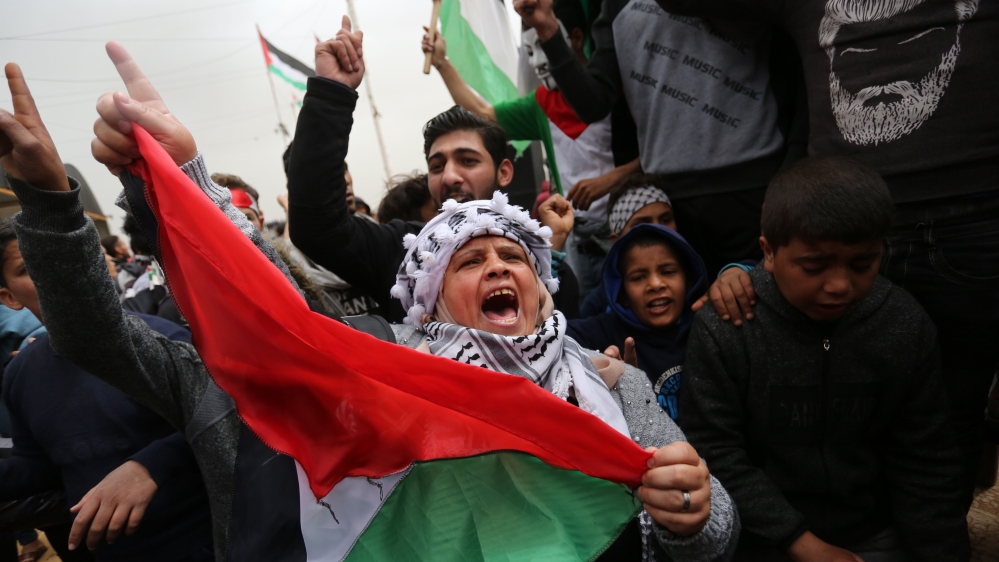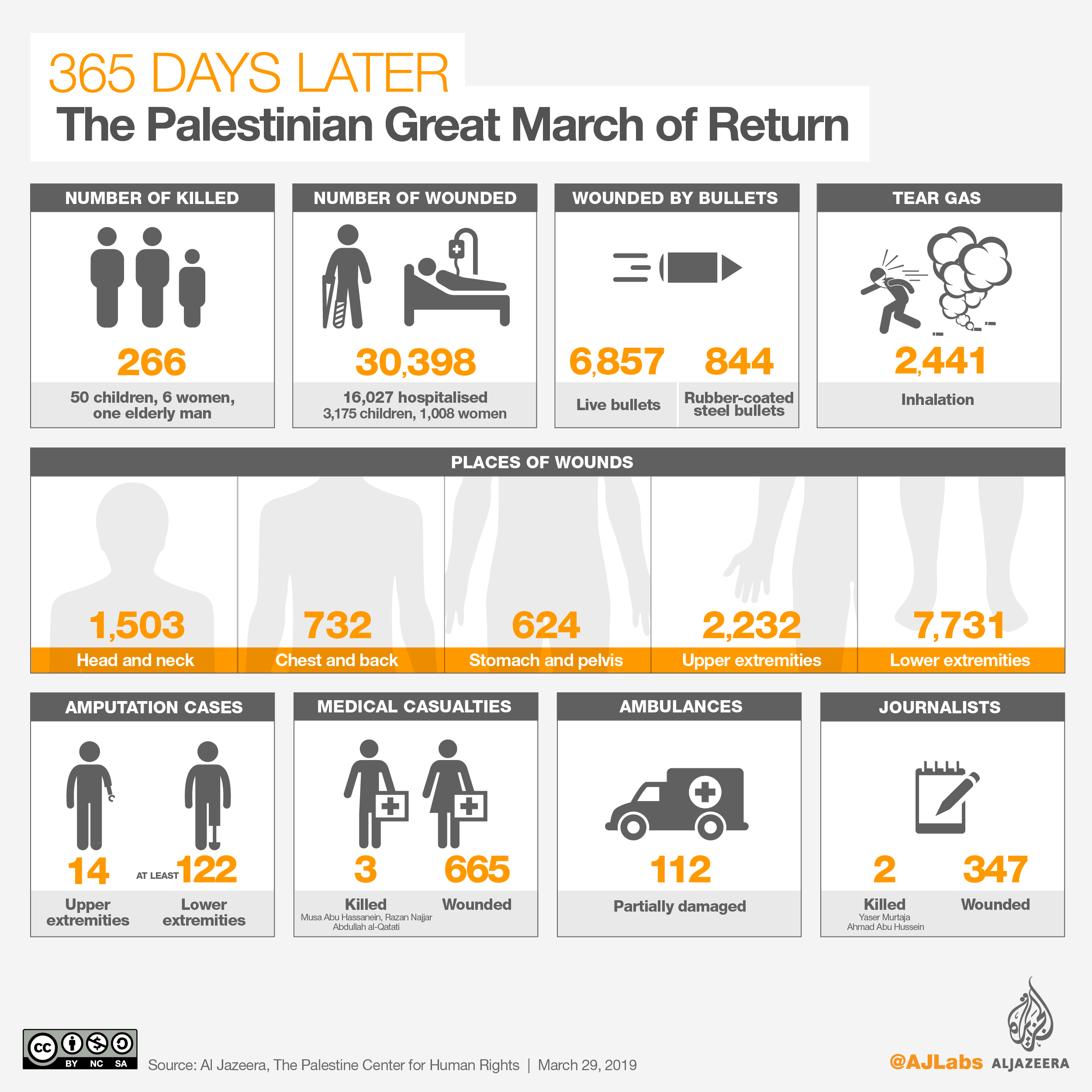‘We’re not leaving’: Gaza marks Great March of Return anniversary
Tens of thousands of Palestinians have rallied at the Israel-Gaza fence to mark the first anniversary of the ‘Great March of Return’ protests, facing off against Israeli tanks and troops massed on the fortified perimeter.
Israeli forces used live rounds, rubber bullets and tear gas on protesters on Saturday, killing a 17-year-old boy at a protest site east of Gaza city, and wounding at least 59 people, according to Gaza’s health ministry.
Another Palestinian was killed in an overnight demonstration ahead of the main protest, the ministry said.
Clashes appeared limited as dozens of Palestinian volunteers in fluorescent tried to keep people back. But warnings to stay far back from the heavily fortified fence were not being heeded by all.
“We will move towards the borders even if we die,” said Yusef Ziyada, 21, his face painted in the colours of the Palestinian flag. “We are not leaving. We are returning to our land.”
Despite heavy rain, some 40,000 people were gathered at the frontier area, the Israeli army said.
Most protesters were keeping away from the fence, but some hurled stones and explosive devices at the structure and set tires ablaze, the army said, adding it was responding with “riot dispersal means and firing in accordance with standard operating procedures”.
 |
|
The Great March of Return protests began on March 30 last year after civil society groups in Gaza called for action against the crippling Israeli blockade against the enclave [Ashraf Amra/Anadolu] |
For the past year, the Israel-Gaza fence been the scene of mass protests and major bloodshed in which more than 260 Palestinians were killed, mostly by Israeli sniper fire. Nearly 7,000 others were shot and wounded, according to Gaza’s health ministry.
The protests call for Palestinians to have the right to return to land from which their families fled or were forced to flee during Israel’s founding in 1948. Israel rejects any such return, saying that would eliminate its Jewish majority.
Palestinian demonstrators also want the lifting of a security blockade imposed on the coastal enclave by Israel and Egypt. Humanitarian agencies blame the blockade for impoverishment in Gaza, where poverty and unemployment rates are high.
The United Nations says more than 90 percent of water is unsafe for drinking, while Gaza’s two million residents receive less than 12 hours of mains electricity a day.
‘Hamas-Israel agreement’
The anniversary of the Great March of Return comes only days after another severe flare-up of violence between Israel and Hamas, which rules Gaza. And Egypt has sought to mediate between the two parties in a bid to rein in violence and avoid the sort of deadly response from the Israeli military that has accompanied past protests.
Al Jazeera’s Harry Fawcett, citing Hamas-affiliated al-Risalah newspaper, said the group had reached a deal with Israel to reduce tensions in the Gaza Strip.
“The Israeli concessions, according to the al-Risalah newspaper, include increasing Qatari funding from $15m to $40m a month to pay salaries; extending the fishing zone from 9 to 12 nautical miles; increasing the electricity supply from Israel into Gaza; and approving a major desalination project,” Fawcett said reporting from the area east of Gaza City.
“In return, Israel has been seeking an end to rocket fire, such as that which destroyed a family home north of Tel Aviv on Monday, injuring seven and sparking a new round of escalation.”
 |
Meanwhile, on the eve of the anniversary protests, organisers issued instructions to demonstrators telling them to stay back from Israeli guns, follow commands of organisers on the ground, refrain from aggressive actions and not to burn tyres, a move seen as a sign that the Egyptian-brokered deal may be adhered to.
Hamas security officers at the scene of the protest were seen wearing military uniforms for the first time, as they picked up tyres and took them away.
“It looks as if they are here to enforce the deal, to make sure that no one sets these tires alight,” Fawcett said.
Israel, which has sent extra troops and tanks to the border, also wants an end to incendiary balloon launches, and a guarantee of calm at the fence.
‘How many years before our lives improve?’
The Great March of Return protests began on March 30 last year after civil society groups in Gaza called for action against the crippling 12 year blockade on the enclave.
March 30 also marks Land Day – the annual commemoration of the deaths of six Palestinians in 1976, who protested the confiscation of their land to build Jewish communities.
“In a year I will finish school. My father is unemployed so I will be unable to go to university. Who is responsible? Israel,” said 16-year-old protester Mohammed Ali.
“I don’t know how many years will pass before our lives improve but we should continue [protests] as long as the occupation and the blockade exist,” he told Reuters news agency.
Israel’s use of lethal force against protesters has drawn censure from the UN and rights groups.
|
Gaza’s “March of Return” protests explained (10:33) |
A UN investigation found that while some demonstrators used violence, the vast majority were unarmed and peaceful. Israeli forces may be guilty of war crimes for using excessive force, it said.
Meanwhile, Israeli Prime Minister Benjamin Netanyahu has been trying to balance projecting military strength with seeking de-escalation before the general election on April 9.
“All Israelis should know that if a comprehensive campaign is required, we will enter it strongly and safely, and after we have exhausted all of the other options,” Netanyahu said.
Hamas is also under domestic political pressure.
Earlier this month, protesters took to the streets instead of the border over price rises and tax hikes. Hamas security put the demonstrations down with beatings and arrests.
At the core of those protests were the same feelings of frustration that, for a year now, have brought thousands to the border, week after week.




